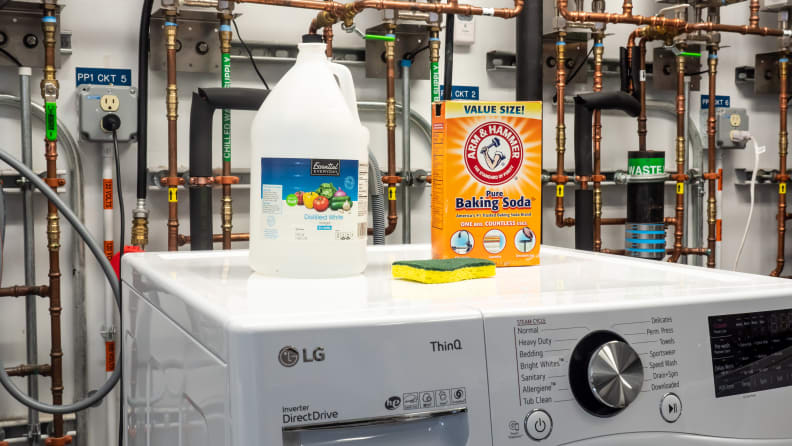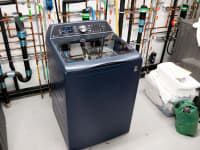This is why your washing machine smells—here's how to clean it
Keep mold and mildew at bay in the washing machine
 Credit:
Reviewed / Getty / RapidEye
Credit:
Reviewed / Getty / RapidEye
Recommendations are independently chosen by Reviewed's editors. Purchases made through the links below may earn us and our publishing partners a commission. Prices were accurate at the time this article was published but may change over time.
There are many good reasons to choose a front-load washer. They’re efficient, gentle on your clothes and great at cleaning.
Unfortunately, the design features that make front loaders so effective also create the perfect conditions for growing mold and mildew. The end result is a washing machine with a terrible smell. What’s worse is that this stink can transfer to your clothes.
We’ll show you how to remove smells by cleaning your washing machine, and prevent mold returning in future.
Why your washing machine smells
It makes sense to assume your washing machine cleans itself with all the detergent and water that runs through it. Unfortunately, this isn’t how it works. To make a parallel, it’s like never cleaning your shower because it gets exposed to soap.
High-efficiency front loading machines use less water than their top-load counterparts, since they fill just the bottom of the washtub with water. The drum rotates on a horizontal axis, and your clothes tumble through the water, eliminating the need to fill the tub up all the way.
That’s all fine and dandy if you use high-efficiency detergent, but when you douse your laundry with the wrong kind of soap and softener, the smaller amount of water can’t fully rinse them away.
In turn, the drum ends up getting coated with a layer of soap scum, which is itself peppered with debris and dirt from your clothing.
In the heat and dampness of your washer, this scum makes a happy home for mildew, bacteria, and mold. These unwelcome guests are the source of the stink.
The smelly washer situation is compounded by the fact that front-load washers use rubber gaskets around the washing machine door to stop water leaks. Dirt, soap, and bits of fabric can get trapped under the gasket, creating yet another breeding ground for nasty smells.

Water, soap scum and dirt lurking behind a washer gasket.
Top-load washers have, but, unlike front-loaders, they don’t use a gasket to keep water in the machine during a cycle. Smells in top-loaders often come from leftover soap or standing water, which can be cleared out by a hot water rinse and spin cycle.
If you own a front-loader, you have to tackle the dirt and odor problem more directly. Here’s our home remedy for deep cleaning your washing machine.
How to clean your front-load washing machine

All you need to keep your washing machine fresh are vinegar, baking soda, and a sponge.
Before your front loader adds funk to your laundry, try these eco-friendly steps to set it right again. Here’s how to clean your washing machine.
Supplies needed:
Prep Time: 10 minutes | Total Time: 1 hour | Difficulty: Easy
Step 1: Mix baking soda and water
Mix ¼ cup of baking soda with ¼ cup of water. Add this solution to your machine’s detergent container.
Step 2: Add vinegar
Pour 2 cups of white vinegar into the drum and run a high heat wash cycle.
Step 3: Scrub with a sponge
Scrub any remaining dirty spots to remove soap scum with the rough side of a sponge dipped in a solution of one part vinegar, one part water.
Step 4: Keep it fresh with every load
To maintain freshness moving forward, use detergents made for high-efficiency machines, keep the drum dry between cycles, and clean the gasket as needed.
How to use Affresh washing machine cleaner
Affresh tablets are a detergent designed to clean the interiors of dishwashers and washing machines. Our experience with it is that it’s designed for places with hard water.
If you constantly find mineral stains on the inside of your washer or on your laundry, Affresh can help keep the deposits to a minimum.
Our one concern is that Affresh contains boric acid—which is a known skin irritant. However, it is one of the best-selling washing machine cleaners.
How to keep your washing machine clean and fresh
Cleaning can fix the odor problem, but mold growth can return if you’re not careful. Fortunately, there are simple steps you can take to minimize washing machine smells in the future.
If you own a front-loader, you should always use detergents made for high-efficiency machines. Normal detergents produce more suds than your front loader can handle; fewer suds means less scum for stinky lifeforms to cling to.
If you’re accustomed to old detergents, you’ll be shocked at how little the amount of HE detergent is recommended per load. Read the directions carefully, and don’t use more than you should.
Liquid fabric softener is also off-limits for front-loading washing machines, so do yourself a favor and ditch it.
Once you’ve got the soap situation under control, it’s time to make sure the drum doesn’t stay damp for long periods of time. Always remove your laundry promptly after the cycle ends, and be sure to leave the door open when it’s not in use. This allows the moisture to escape.
You can also run a fan in the laundry room to improve airflow and consider investing in a dehumidifier.
Even with the correct detergent and anti-humidity efforts, there’s no guarantee your washer drum won’t develop some mold buildup without regular cleaning.
If you notice any mold or smells reappearing, wipe down the rubber seal with a cleaning solution made of one part white vinegar and one part water.
Finally, be sure to dispose of any lint that may have accumulated in your machine’s drain trap filter. Once a week should do the trick. The best washing machine cleaner is prevention.






